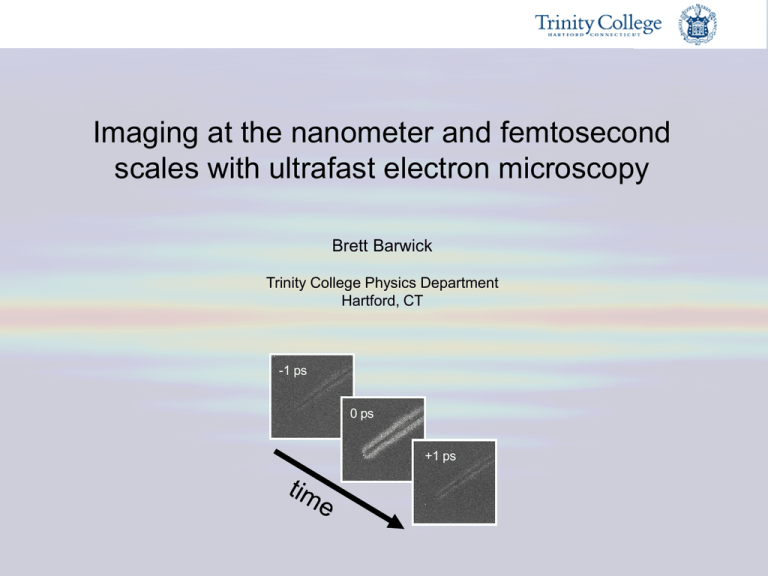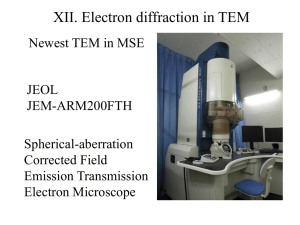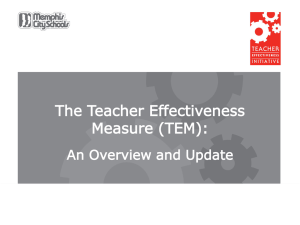Imaging at the nanometer and femtosecond scales with ultrafast
advertisement

Imaging at the nanometer and femtosecond scales with ultrafast electron microscopy Brett Barwick Trinity College Physics Department Hartford, CT -1 ps 0 ps +1 ps Ultrafast electron microscopy at Trinity College - UEM in my lab is based on a point projection ultrafast electron microscope - Chosen for its simplicity, cost and flexibility At Caltech: TEM~ $1 million laser~ $500k Lab ~ $1 million Post docs, graduate students At Caltech: TEM~ $1 million laser~ $500k Lab ~ $1 million Post docs, graduate students At Trinity: Point projection/UEM ~$40k, homebuilt laser ~ donated Undergraduates Dispersion in UEM base on standard TEM: TEM Causes of temporal spread: Space charge Dispersion Assuming no space charge how can we get around dispersion? Dispersion in UEM base on standard TEM: TEM Causes of temporal spread: Space charge Dispersion Assuming no space charge how can we get around dispersion? 1) RF compression, already shown successful for UED in multiple groups Dispersion in UEM base on standard TEM: TEM Causes of temporal spread: Space charge Dispersion Assuming no space charge how can we get around dispersion? 1) RF compression, already shown successful for UED in multiple groups 2) Optical/ponderomotive compression, should work in principle not demonstrated Dispersion in UEM base on standard TEM: TEM Causes of temporal spread: Space charge Dispersion Assuming no space charge how can we get around dispersion? 1) RF compression, already shown successful for UED in multiple groups 2) Optical/ponderomotive compression, should work in principle not demonstrated 3) Don’t let the pulse have the time to disperse Length scales in TEM versus point projection EM: TEM ~1 m PPEM ~10 µm Modeling: Advantage of point projection versus UEM base on standard TEM - Standard UEM’s are limited – dispersion causes reduction in temporal resolution - PPUEM, with tip very close to specimen can be one solution to this problem “Femtosecond photoelectron point projection microscope”, Erik Quinonez, Jonathan Handali and Brett Barwick. Review of Scientific Instruments. 84, (2013) 103710. Ultrafast nanometer tip sources have been shown to produce sub-cycle attosecond electron packets Current progress and device characterization Our device: “Femtosecond photoelectron point projection microscope”, Erik Quinonez, Jonathan Handali and Brett Barwick. Review of Scientific Instruments. 84, (2013) 103710. Characterization: Imaging with photoelectrons “Femtosecond photoelectron point projection microscope”, Erik Quinonez, Jonathan Handali and Brett Barwick. Review of Scientific Instruments. 84, (2013) 103710. Characterization: Imaging with photoelectrons 56 eV photoelectrons ~80MHz, ~1 sec exposure “Femtosecond photoelectron point projection microscope”, Erik Quinonez, Jonathan Handali and Brett Barwick. Review of Scientific Instruments. 84, (2013) 103710. Characterization: Emission time of electrons Δt single pulse Δt electron detector double pulse tip electron pulse “Femtosecond photoelectron point projection microscope”, Erik Quinonez, Jonathan Handali and Brett Barwick. Review of Scientific Instruments. 84, (2013) 103710. Characterization: Emission time of electrons Δt single pulse Δt electron detector double pulse tip electron pulse “Femtosecond photoelectron point projection microscope”, Erik Quinonez, Jonathan Handali and Brett Barwick. Review of Scientific Instruments. 84, (2013) 103710. Characterization: Time of flight energy analysis Femtosecond laser pulses 2-D Electron detector 13 ns Photodiode Correlation electronics “Femtosecond photoelectron point projection microscope”, Erik Quinonez, Jonathan Handali and Brett Barwick. Review of Scientific Instruments. 84, (2013) 103710. Characterization: Time of flight energy analysis Femtosecond laser pulses TOF spectra 2-D Electron detector 13 ns Photodiode Correlation electronics “Femtosecond photoelectron point projection microscope”, Erik Quinonez, Jonathan Handali and Brett Barwick. Review of Scientific Instruments. 84, (2013) 103710. Characterization: Time of flight energy analysis Femtosecond laser pulses TOF spectra 2-D Electron detector 13 ns camera Photodiode Correlation electronics Simultaneously obtain an image -need a delay line detector “Femtosecond photoelectron point projection microscope”, Erik Quinonez, Jonathan Handali and Brett Barwick. Review of Scientific Instruments. 84, (2013) 103710. Simulation: Sample spectra of photon induced near field spectra - 25 eV electrons - pump laser of 800 nm - convoluted with detector resolution of 1 ns Current progress: - Modeling shows very little dispersion in principle - Imaging in pulsed mode with ~ 10 nm resolution - TOF energy spectroscopy is demonstrated Currently: Need to find “time zero” “Femtosecond photoelectron point projection microscope”, Erik Quinonez, Jonathan Handali and Brett Barwick. Review of Scientific Instruments. 84, (2013) 103710. Currently: Need to find “time zero” pump with tens of mJ/cm^2 Currently: Need to find “time zero” - Two main lasers in my lab - Oscillator, 80MHz, several nJ, 100 fs - Amplifier, 20Hz, 20 mJ, 100fs pump with tens of mJ/cm^2 - Oscillator, enough electrons, not enough pump pulse energy - Amplifier, not enough electrons, plenty of pump pulse energy - Need ~ 1 MHz, ~ 1 µJ and 100 fs or less for this method Currently: Need to find “time zero” - Instead use oscillator and use local field enhanced fields due to optically excited plasmons Image taken using photon induced near field electron microscopy “Photon Induced Near-Field Electron Microscopy” Nature, 462 (2009) 902-906. Use enhanced field to deflect the electron pulses Advantages: - excitation can be pumped with an oscillator - microscope has sufficient spatial resolution - low energy electrons are very sensitive - excited fields follow the optical field of the excitation laser Future: Imaging attosecond dynamics at the nanoscale? metallic nanoparticle (d<<λ) E -- - - - t time t E - - - -++ + ++ E ++ ++ + time t+T/2 -attosecond PEEM is already at as and nm scales Femtosecond laser pulses 2-D Electron detector 13 ns Photodiode Correlation electronics Ultrafast low energy electron interferometry Interaction region for experiments Femtosecond laser pulses Electron detector 13 ns 2-D Electron detector Photodiode Correlation electronics Correlation electronics “AMO” type experiments include - Scalar AB effect - Time-dependent decoherence effects - Hanbury-Brown Twiss effect (or antibunching of electrons) Future: TEM based UEM at Trinity? Trinity Students that have worked on these projects: Jonathan D. Handali, 2013 Erik Quinonez, 2014 Bhola Uprety, 2014 Pratistha Shakya, 2015 Abhishek Khanal, 2015 This work was supported by FRC, Trinity Startup Funds and CT Space Grant, and special thanks to Prof. Ahmed Zewail for donation of the laser system.










